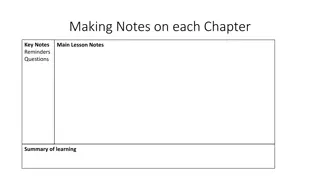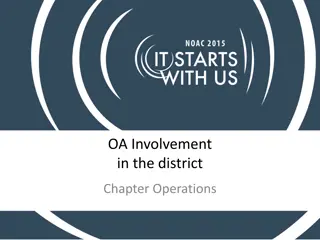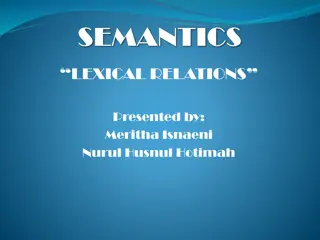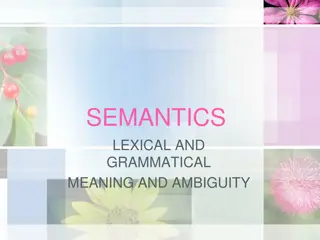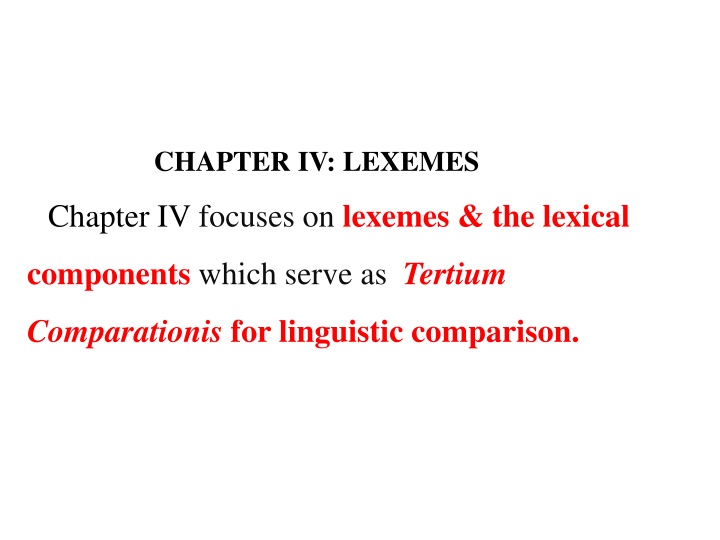
Understanding Lexemes in Linguistics
Explore the concept of lexemes, the smallest units in the meaning system of language, and their significance in linguistic analysis. Learn about the differences between lexemes and words, as well as methods for studying the meanings of lexemes such as semantic roles and cognitive concepts.
Download Presentation

Please find below an Image/Link to download the presentation.
The content on the website is provided AS IS for your information and personal use only. It may not be sold, licensed, or shared on other websites without obtaining consent from the author. If you encounter any issues during the download, it is possible that the publisher has removed the file from their server.
You are allowed to download the files provided on this website for personal or commercial use, subject to the condition that they are used lawfully. All files are the property of their respective owners.
The content on the website is provided AS IS for your information and personal use only. It may not be sold, licensed, or shared on other websites without obtaining consent from the author.
E N D
Presentation Transcript
CHAPTER IV: LEXEMES Chapter IV focuses on lexemes & the lexical components which serve as Tertium Comparationis for linguistic comparison.
* Definition: Lexeme (lexical item) - the smallest unit in the meaning system of a language. * Like a word, Lexeme can be separated from other units in utterances; Lexeme has meaning & takes place in both spoken & written forms. She is a doctor.
Lexeme & word difference * Lexeme - the set of inflected forms taken by a single word. Ex. the lexeme run including as members "run" (lemma/lexical entry- dictionary form), "running" (inflected form), or "ran & excluding "runner" (derived term) * Word - the fact or action of speaking, as opposed to writing or to action.
* Lexeme (word) - a fundamental unit of the lexicon (word stock) of a language. * A lexeme is often, but not always an individual word. It is sometimes called simple lexeme or dictionary word which may have number of inflectional forms or grammatical variants: talk- talks,talking, talked
* LEXEME = A WORD + ITS FORMS. * THE DIFFERENCES BETWEEN WORD & LEXEME: * WORD INDECATING FACT or ACION, LEXEME IS THE SET OF INFLECTED FORMS. Ex. Give > gives, gave, giving, given
* The ways to study meaning of lexemes: Semantic roles, Semantic properties, Semantic fields, Semantic primaries, Cognitive concepts. * Fundamental lexical semantic topics for Vietnamese learners of English are general meaning of word class/parts of speech, lexeme, semantic fields, cognitive concepts.
* Meaning of each lexeme is comprised of some semantic primaries (original meaning). * One of the semantic primaries is the meaning of word class (parts of speech) which is common grammatical categories for languages. * > Each part of speech shares some general contents & common morphological categories (expressions-forms).
Morphological categories refer to synthetic languages (inflectional languages, such as English, French, Russian). Words in synthetic languages are formed by affixing a given number of dependent morphemes to a root morpheme. Ex. work > works, working, worked; book > books; > The word changes it s form by adding affixations.
Morphological categories (Expression) in analytic languages (monosyllabic languages such as Vietnamese, Thai & Chinese) hides in word collocation (combination). Ex. ang l m vi c, nhi u cu n s ch (cu n, quy n, c i, chi c (t ch lo i/classifier) working
Each part of speech has its general meaning (content) & its form (morphological expression). English lexemes share both synthetic & analytic characteristics. In English, lexical categories demonstrated throughout morphological expressions - suffixes.
Ex. The general meaning of verb expressed by: -ate, -en, -fy, -ize, -ise; of noun by: -ance, -ence, -eer, -er, -ion, -ity, -ment, -ness, -or, - sion, -ship; of adjective by: -able, -ible, -al, - ant, -ful, -ic, -ious, -ous, -ive, -less, -y; & of adverb by: -ly, -ward, -wise.
The English morphological categories differ from Vietnamese. The difference is what makes the Vietnamese difficult in English communication, especially in forming interrogative or negative sentences. In English there are many lexemes that share the same forms, but differ in parts of speech, i.e. differ in some aspect of meaning. Ex. answer can be a noun, a verb
Exercise: Analyse an English sentence & its Vietnamese equivalent: Each team must have five people. M i i ph i c n m ng i. They are equivalent in semantics. English sentence is comprised of six words in basic forms. There are two syntactical constituents in each sentence: a predicate & a subject. The subjects are noun phrases. The predicates are verb phrases with head verbs & sub-verb phrases. The process of specifying parts of speech (or the similarities in syntactic positions of word classes) is described.
It is easy to realize nominal & verbal expressions. In the third stage, team & i are recognized as nouns; must & ph i are verbs. In the fourth stage have & c verbs. & in the fifth people & ng i nouns. The mentioned lexical categories are determined by the relationship between syntactical constituents of "Each team must have five people" & "M i i ph i c n m ng i".
Subtypes of word classes Each part of speech is divided into subtypes according to their general meanings & their morphological expressions.
Ex. Noun (part, class, or group of words) includes Proper & Common nouns. Common nouns divided into concrete, abstract, count & mass nouns. Verbs (class, or group of words): transitive, intransitive, ditransitive & auxiliary verbs. Subtypes of word class can work for objects of contrastive studies.
Contrastive lexeme analysis Each lexeme is comprised of its meaning (content) & expression (form). Meaning usually serves as Tertium Comparationis for contrastive studies. Contrastive studies on lexemes can be conducted in the perspective of structural, generative, or functional approaches.
Similarities & differences in lexemes in the perspective of language variants Many words that are similar or relate to each other in meaning or in sound: hyponyms, synonyms, homonyms, antonyms. Hyponyms -Aterm which is more specific than some other term & has a narrower denotation. Ex. Animal: cat, dog, tiger, elephant, horse (hyponyms)
Homonyms- Lexemes or expressions that share the same form (in spelling, in pronunciation) but have different senses. Ex. hear /hi / & here /hi / ; bow /bau/= bend at the waist & bow /b u/ = weapon. Synonym - Two or more lexemes or other expressions with the same meaning: lover sweetheart boyfriend - girlfriend, Antonyms - Two or more lexemes or other expressions with opposite meanings: short-tall, beautiful-ugly,
>All of hyponyms, synonyms, homonyms, and antonyms are objectives of Intralingual & Interlingual contrastive studies.
Similarities & differences in lexemes in different languages A word in language A has its equivalent in language B. They share nearly the same meaning, differ in writing. Ex. word table has the following equivalents in Vietnamese: 1. c i b n; 2. th c nd n tr n b n; 3. b ngs ; 4. b ng; 5. li t k s ki n; 6. m tph ng; 7. b ngg , ; 8. ch ghi tr n b ng.
In contrast, Vietnamese word bn has the following meanings: B n. d ng th ngb ngg c m tph ng v ch n ng, b y c, th c n, l m vi c,...B n vi t. B n. L n t nh c, thua trong tr n u b ng. Ghi m t b n th ng. L m b n (t o ra b n th ng). B n. Trao i ki nv vi c g ho cv n g . B n c ng t c. B n v c ch l m.
Each lexeme (or word) expresses certain content (experience) in language user's mind. Accordingly, each language community encompasses their own concept of a thing. Ex. Concept expressed by wood in English shares the meaning with other linguistic items described as in Table
Intralingual contrast * Learners compare words & phrases in particular contexts. Ex.1: Circle the correct answer. I hope to go on a trip round the world / earth one day. (World indicates a place or the area within the planet earth. World can indicate a place or area that is outside planet earth too if humans happened to live there. ... The word earth indicates the planet called the Earth.) * Common platform for the contrast is the meaning of lexeme Intralingual contrast takes place between not only two linguistic units but also more units.
Interlingual contrast * Each lexeme has a certain meaning that can be interpreted from one language to another. * Each lexeme reflects language user's perception & experience. * A lexeme in language A is not absolutely equivalent to its translation in language B. * Specifying the differences between lexemes in different languages helps understanding sociocultural linguistic characteristics & improving communicative language competence.
* TC for interlinguistic CS on lexemes is their translation equivalent. * English shares both synthetic&analytic characteristics. Forms of an English word is changed/inflected * Vietnamese is analytic (form of a word is not changed). >Contrastive studies on English & Vietnamese lexeme are usually based on translation equivalent.
Contrastive concept analysis * CS on lexemes can be conducted in the perspective of cognitive theory. * Linguistic cognitive approach studies how people comprehend & represent the world around them through language & emphasizes on individual s active construction of understanding.
* Linguistic meaning - a property of the utterance, lexical representations consist of the mental abstractions & must be stored as part of the language user's knowledge of language. * Words are only as contextual expressions embedded in utterance & its meaning is variable across language use.
From the theoretical approach, lexical conceptual unit, lexical profile & lexical representation serve as common platforms for contrastive studies. Lexical concept - a bundle of various types of schematic knowledge conventionally associated with a unique phonological vehicle in a symbolic unit. Lexical concepts are stored in the linguistic system & can facilitate access to conceptual structure.
Lexical conceptual unit - an integrated unit of linguistic content which is the result of lexical concept integration. Lexical profile - the selection tendencies which form part of the linguistic content encoded by a lexical concept, & which is unique to any given lexical concept.
Lexical representation - the primary substrate in linguistically mediated meaning construction. Lexical representation is made up of symbolic unit & cognitive model. Many cognitive researchers suggest their terms, but they are equivalents. In contrastive studies,lexical concept refers content (or idea), & lexical representation refers to linguistic expression.
Cognitive model: M hnh nhn th c l m t t i kho n m t ho c tr nh b y t nh to n v suy ngh c a con ng i v m t kh i ni m, k n ng ho c l nh v c nh t nh
Prototype (tinmu/ngha tiu biu/ kiumu xc nhi t ngm i) The typical conceptual units are called prototypes which are the best example of a conceptual category. The less typical units are seen as its peripheral (ngo i vi) members. Ex. a prototype of a bird - like a parrot, a sparrow, or a dove, a penguin, or a kiwi
Lexical concept * Lexical concepts are cognitive entities that are based on perceptual experience, which means that they are embodied. * CONCEPTS ARE COMMON IN MEANING but it is expressed in different ways in different languages
Concepts of time in English, Russian, Vietnamese, etc. are common in meaning, but it is expressed in different ways. In English, there are Present Simple Tense, Present Perfect, Past Continuous, etc., & they are expressed in different forms, but Vietnamese does not have such fine distinction of tenses & aspects as in English.
* People are born with a conceptualizing capacity. However, different communities may have unalike conceptual systems due to their different experiences. Ex. The spatial concepts of tr n & d i & the corresponding verbs l n & xu ng in Vietnamese belong to the basic conceptual systems as they can be projected to social relationships.
* When someone is promoted, he is said to be ln ch c . If he is downgraded, he is xu ngch c . Such examples can be extensively found in Vietnamese. * Rice is very familiar to Vietnamese, hence the different categories l a , g o , c m, th c . * Nonetheless, it is not native to English speakers, & thus it has only one word rice to represent the 4 concepts as conceptualized by Vietnamese.
Semantic primes/semantic primitive The authors of natural semantic metalanguage approach suggest the universal semantic primes for many languages (including Russian, Polish, French, Spanish, Danish, Chinese, Japanese, Korean, Lao, Malay, Mbula/Mangaaba-Mbula, Koromu, PNG, Tok Pisin, Amharic, Arabic, East Cree, Finnish, & many others)
Lexical cognitive concept Concepts are based on perceptual experience. It means, they are grounded in our daily experience. Conceptual metaphors Conceptual metaphor - a set of correspondences between a more physical source domain & a more abstract target domain. Conceptual metaphors are grounded in our physical & cultural experience.
* Metaphorsis to name things, or this phenomenon by name of things, other phenomenon have similarities with the effect of increasing evocative & sensual. Functions of Metaphor: Enriches the vocabulary of a language; Creates new ways of speaking; Makes speaking concise, Lets the speaker express all levels of their emotions & attitudes. Since the essence/nature of the metaphor is comparison, so the cognitive function of comparison is the cognitive function of the metaphor.
*Characterized by the formula A is B, in which a target domain A understood in terms of a source domain B. * The most common source domains by Kovecsces: (1) The Human Body, (2) Health and Illness, (3) Animals, (4) Plants, (5) Buildings and Construction, (6) Machines and Tools, (7) Games and Sport, (8) Money and Economic Transactions (Business), (9) Cooking and Food, (10) Heat and Cold, (11) Light and Darkness, (12) Forces, and (13) Movement and Direction.
* The common target domains are (1) Emotion, (2) Desire, (3) Morality, (4) Thought, (5) Society / Nation, (6) Politics, (7) Economy, (8) Human Relationships, (9) Communication, (10) Time, (11) Life and Death, (12) Religion, and (13) Events & Actions. Ng i Cha m i t c b c t l a cho anh n m The silver-haired Father Fires the fire for him to lie down
Conceptual metaphors characterized by common models in almost languages. They are common platform for contrastive studies. Contrastive analysis on concepts in English & Vietnamese * Experiencing- feeling/emotion in English & Vietnamese One of the exponents of feel in both of English & Vietnamese is to experience one s emotion. The concept expressed by various linguistic forms. Ex. Examining the idea of experiencing feeling/emotion demonstrated by words heart in English & l ng in Vietnamese.
The TC for the contrast is concept of experiencing emotion. Experiencing emotion expressed by heart . Heart - The thing that controls one's emotion. The idea can be seen in English proverbs: A blithe heart makes a blooming visage (face sight); The joy of the heart makes the face fair; It is a poor heart that never rejoices; Fear is the prison of the heart.
Heart in idioms & colloquial expressions with heart represent various aspects of feeling/emotion: love, joy, hatred, fear & jealousy. Ex. * break someone s heart (l m tan n t tim ai), * eat your heart out (d nv t m nh (v ghen tu ng, ghen t , h ih n, ti c ) * gladden the/(one s) heart (l m cho ai vui l ng), * heart breaks (bu n x ru t), * heart skips a beat (th n kinh v ng), * heavy heart (tr u l ng/ h o ru t), * melt (one s) heart (ch n tay b nr n/ h n xi u,/th t tim), * nearly gave (one) a heartattack (l m th t tim, l m ng i ta s h th n), * heart leaps (s ngr nng i). >As above illustration, in English, heart in different collocations can indicate various states of emotion.
Experiencing emotion expressed by lng *L ngin Vietnamese - a physical part of body/ internal organs. * The expression used to describe various aspects of emotion: m t l ng, aul ng, ph il ng, y n l ng, l ng b ih i, l ng th ng L ngb ih i nao nao/ Con ngx a c n / M ng ix a c c n kh ng?; L ng xao xuy nm i khi hoa ph ngr i. M tn mm i angv /Th yvui trong l ng, d ng xu n m m ng.
Lng has its components such: tim, gan, mt, b ng, ru t They can be used to represent emotion: gi nb mgan, t m ru t , s v m t , s th t tim , c i auc b ng , t cl nru t
Similarities & differences between experiencing emotion expressed by heart & l ng The similarities Both English heart & Vietnamese l ng (& its exponents) can be used as mental entities to indicate various aspects of psychological status.
The differences Experience of emotion explained by different parts of human body in English & Vietnamese. When a status of emotion is indicated in English by only heart referring to a part of the body, it is interpreted in some Vietnamese expressions that do not always refer to the heart, but to the other internal organs: liver, gallbladder, stomach, intestin (large & small) etc.
Some psychological aspects of emotion expressed by Vietnamese tim, l ng, tim, gan, m t, b ng, d , ru t are not always interpreted by English heart: l ng th ng compression, l ng c m th hatred, l ng ghen t - envy, vui l ng, h d - have stars in one's eyes, b m gan t m ru t rage), etc. - black in the face (with






